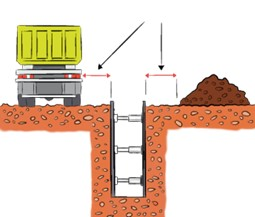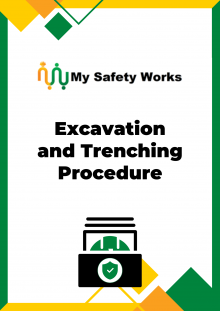Description
What is an Excavation and Trenching Procedure?
An excavation and trenching procedure is a written document that outlines the steps necessary to safely and effectively trench and/or excavate an area. The procedure sets out the minimum standards for developing, implementing and improving ground trenching and excavation operations to protect workers, the environment, plant and equipment.
An excavation and trenching procedure enables the safety of personnel working in or near excavations and trenches and near the associated earthworks. Trenching and excavation work are common construction activities that, if not properly executed, can result in serious injuries or even death.
What is the Difference Between an Excavation and a Trench?
An excavation is a hole in the earth, or a face of the earth, formed after rock, sand, soil or when other material is removed (excavation work is the work undertaken to make, fill or partly fill an excavation).

Various Types of Excavations
A trench is a horizontal or inclined way or opening that:
- Has a length that is greater than its width and is also greater than or equal to the depth of the trench.
- Commences at and extends below the surface of the ground; and
- Is open to the surface along its length and/or width.
Note: If working in a trench with an excavated depth greater than 1.5 metres, this task is classified as a ‘high-risk construction work’ (HRCW) under the WHS regulation and a safe work method statement (SWMS) is mandatory.
General Safety with Trenches and Excavations
To prevent hazards for workers, the environment and equipment, thorough planning and preparation are essential before any excavation and trenching work commences.
Information must be collected regarding facilities and underground (or other potentially concealed) services near the planned excavation or trench.
In addition, effective communications between regulatory agencies, service providers, (e.g. Dial Before You Dig – DBYG) utility companies, property owners and other third parties should be undertaken to ensure essential information is shared and the excavation or trenching activities are properly coordinated and performed.
Before commencing any excavating or trenching work a risk management process should be followed with specific attention to:

Ensure a Safe Distance from Edges
- The job sequence and the appropriate type of equipment required.
- Consultation with workers and competent persons and the provision of training, instruction and competencies.
- Communication requirements while working in or near the excavation or trench.
- The soil conditions and any engineering mechanisms to prevent unplanned collapse.
- Potential exposure to airborne contaminants or hazardous materials.
- Provision of safe work area access, egress and fall prevention controls.
- Street cut safety precautions.
- Protective systems to prevent cave-ins and trench boxes.
- Protective systems and protective equipment to prevent cave-ins or a person falling into a trench.
- Prevention of unauthorized access and falling into the excavation.
- Confined space excavations and unprotected trenches.
- Identification and marking of any services, both overhead and underground.
- The process for removal of excavated materials (e.g. transport, plant or dewatering equipment systems, etc.).
- Possible low-visibility conditions and supplementary lighting.
- Implementation of emergency rescue procedures.
Contents of this Excavation and Trenching Procedure
- Approval.
- Purpose.
- Scope.
- Terms and Definitions.
- Roles and Responsibilities.
- Procedures.
- General Excavation and Trenching Safety.
- Underground Services.
- Permit to Excavate
- Inspections.
- Access and Egress to Enter a Trench or Excavation.
- Barricading and Signage.
- Excavation Stability.
- Benching or Battering.
- Shoring and Shielding.
- Loads Near Excavations.
- Spotters.
- Environmental Impacts.
- Training and Competency.
- Related Procedures, Forms and Documents.
- Review Criteria.
- Record Management.
- References.
Why Choose to Buy this Excavation and Trenching Procedure
- This 11-page excavation and trenching procedure can assist you set out the minimum standards for the work health and safety requirements with trenching and excavation operations.
After purchasing this excavation and trenching procedure you will be able to:
- Very easily edit and customize the template to create your own excavation and trenching procedure.
- Apply your own style, format and brand to the procedure.
- Use it in any industry or sector regardless of the size or type of organization.
Availability and Use of this Excavation and Trenching Procedure
- This excavation and trenching procedure is accessible to you right now by clicking the ‘Buy Now’ button.
- The procedure will be delivered to you in fully editable Microsoft Word format for immediate and full use in your business.
- There are no subscriptions, contracts or ongoing costs.

This excavation and trenching procedure is 100% satisfaction guaranteed.
You may also require:



